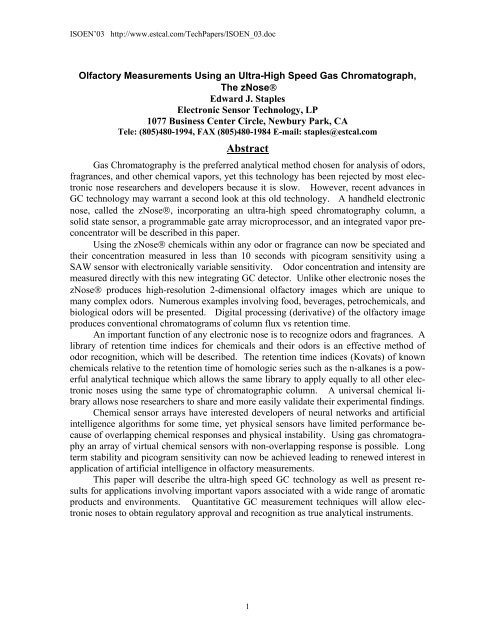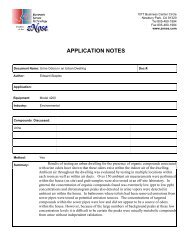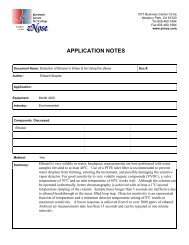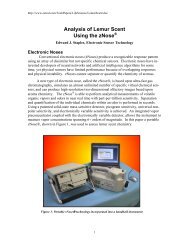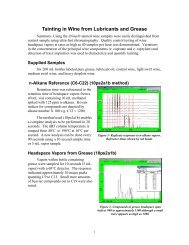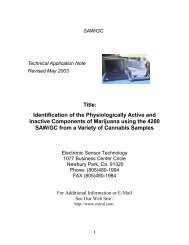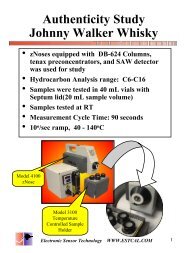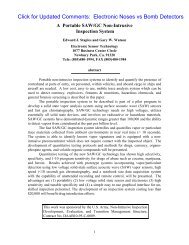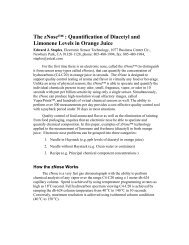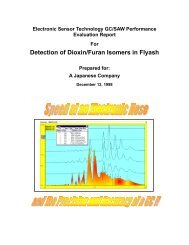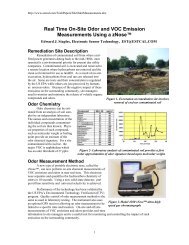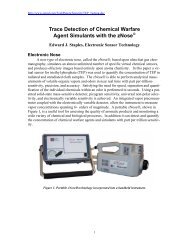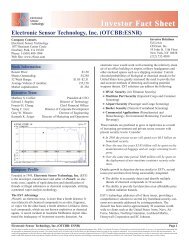ISOEN_03.doc - Electronic Sensor Technology
ISOEN_03.doc - Electronic Sensor Technology
ISOEN_03.doc - Electronic Sensor Technology
Create successful ePaper yourself
Turn your PDF publications into a flip-book with our unique Google optimized e-Paper software.
<strong>ISOEN</strong>’03 http://www.estcal.com/TechPapers/<strong>ISOEN</strong>_<strong>03.doc</strong><br />
Olfactory Measurements Using an Ultra-High Speed Gas Chromatograph,<br />
The zNose®<br />
Edward J. Staples<br />
<strong>Electronic</strong> <strong>Sensor</strong> <strong>Technology</strong>, LP<br />
1077 Business Center Circle, Newbury Park, CA<br />
Tele: (805)480-1994, FAX (805)480-1984 E-mail: staples@estcal.com<br />
Abstract<br />
Gas Chromatography is the preferred analytical method chosen for analysis of odors,<br />
fragrances, and other chemical vapors, yet this technology has been rejected by most electronic<br />
nose researchers and developers because it is slow. However, recent advances in<br />
GC technology may warrant a second look at this old technology. A handheld electronic<br />
nose, called the zNose®, incorporating an ultra-high speed chromatography column, a<br />
solid state sensor, a programmable gate array microprocessor, and an integrated vapor preconcentrator<br />
will be described in this paper.<br />
Using the zNose® chemicals within any odor or fragrance can now be speciated and<br />
their concentration measured in less than 10 seconds with picogram sensitivity using a<br />
SAW sensor with electronically variable sensitivity. Odor concentration and intensity are<br />
measured directly with this new integrating GC detector. Unlike other electronic noses the<br />
zNose® produces high-resolution 2-dimensional olfactory images which are unique to<br />
many complex odors. Numerous examples involving food, beverages, petrochemicals, and<br />
biological odors will be presented. Digital processing (derivative) of the olfactory image<br />
produces conventional chromatograms of column flux vs retention time.<br />
An important function of any electronic nose is to recognize odors and fragrances. A<br />
library of retention time indices for chemicals and their odors is an effective method of<br />
odor recognition, which will be described. The retention time indices (Kovats) of known<br />
chemicals relative to the retention time of homologic series such as the n-alkanes is a powerful<br />
analytical technique which allows the same library to apply equally to all other electronic<br />
noses using the same type of chromatographic column. A universal chemical library<br />
allows nose researchers to share and more easily validate their experimental findings.<br />
Chemical sensor arrays have interested developers of neural networks and artificial<br />
intelligence algorithms for some time, yet physical sensors have limited performance because<br />
of overlapping chemical responses and physical instability. Using gas chromatography<br />
an array of virtual chemical sensors with non-overlapping response is possible. Long<br />
term stability and picogram sensitivity can now be achieved leading to renewed interest in<br />
application of artificial intelligence in olfactory measurements.<br />
This paper will describe the ultra-high speed GC technology as well as present results<br />
for applications involving important vapors associated with a wide range of aromatic<br />
products and environments. Quantitative GC measurement techniques will allow electronic<br />
noses to obtain regulatory approval and recognition as true analytical instruments.<br />
1
<strong>ISOEN</strong>’03 http://www.estcal.com/TechPapers/<strong>ISOEN</strong>_<strong>03.doc</strong><br />
New Analytical Tool for Odor Measurements, the zNose®<br />
A new type of ultra-fast gas chromatograph, the zNose®, is able to perform analytical<br />
measurements of volatile organic vapors and odors in near real time with picogram sensitivity.<br />
Because of its picogram sensitivity it is a useful tool for quantifying the organic<br />
chemistry of a diverse number of odors and fragrances. The zNose® separates and quantifies<br />
the organic chemistry of odors through ultra-high speed chromatography, typically in<br />
10 seconds. Using an uncoated solid-state mass-sensitive detector, picogram sensitivity,<br />
universal non-polar selectivity, and electronically variable sensitivity has been achieved.<br />
An integrated vapor preconcentrator coupled with the electronically variable detector, allow<br />
the instrument to measure vapor concentrations spanning 6+ orders of magnitude. A<br />
portable zNose®, shown in Figure 1, is a useful tool for on-site odor and ambient air<br />
measurements as well<br />
Figure 1- zNose® technology incorporated into 3 commercial instruments.<br />
How the zNose® Quantifies the Chemistry of an Odor<br />
A simplified diagram of the zNose® system shown in Figure 2 consists of two parts.<br />
One part or section uses helium gas, a capillary tube (GC column) and a solid-state detector.<br />
The other part consists of a heated inlet and a pump, which draws ambient air into the<br />
instrument at a fixed flow rate, typically 0.5 milliliter/second. Linking the two sections is<br />
a “loop” trap, which acts as a preconcentrator when placed in the air section (sample position)<br />
and as an injector when placed in the helium section (inject position). Operation is a<br />
two-step process. Ambient air (odor) is first sampled and organic compounds within the<br />
air are collected (preconcentrated) on the trap. After sampling the trap is switched into<br />
the helium section where the collected organic compounds are injected into the helium<br />
flow. The organic compounds are separated as they pass through a temperature programmed<br />
GC column. Each compound typically has a different velocity and exits the column<br />
at a characteristic retention time. Speciation or identification is based upon each<br />
2
<strong>ISOEN</strong>’03 http://www.estcal.com/TechPapers/<strong>ISOEN</strong>_<strong>03.doc</strong><br />
compound’s unique retention time. As each compound (analyte) exits the column it is detected<br />
and quantified by a solid-state mass detector consisting of a temperature controlled<br />
surface acoustic wave (SAW) crystal. Detector sensitivity (physical absorption onto the<br />
front quartz surface) is a function of crystal temperature and electronic temperature control<br />
is achieved by attaching the backside of the SAW crystal to a thermoelectric element.<br />
Figure 2- Simplified diagram of the zNose showing an air section on the right and a<br />
helium section on the left. A loop trap preconcentrates organics from ambient air in the<br />
sample position and injects them into the helium section when in the inject positron.<br />
A high-speed gate-array microprocessor controls the processing of odor samples and<br />
includes electronic flow control, timing, electronic injection, and temperature control for<br />
the column, inlet, detector, and other parts of the instrument. The user interface, which is<br />
responsible for sending macro instructions to the microprocessor and displaying measurement<br />
results, can be a laptop computer or a remote computer using a wireless modem (1<br />
mile range). A software program allows users to select appropriate measurement methods<br />
and to identify specific organic compounds in odors or fragrances from a library of Kovats<br />
indices.<br />
3
<strong>ISOEN</strong>’03 http://www.estcal.com/TechPapers/<strong>ISOEN</strong>_<strong>03.doc</strong><br />
2 Dimensional Olfactory Images: Odor Intensity vs Volatility<br />
The chemistry of odors and fragrances involve what are called organic compounds<br />
spanning an increasing molecular weight and decreasing volatility. As these organic compounds<br />
exit the column they impinge upon a constant temperature SAW mass sensor. Low<br />
molecular weight and more volatile organics condense and re-evaporate from the surface<br />
of the crystal quickly while high molecular weight compounds adhere to the crystal surface.<br />
In either case the frequency deviation of the crystal is proportional to the amount of<br />
each compound present in the effluent of the GC column. In effect the frequency deviation<br />
of the crystal can be used as a measure of the odor intensity vs volatility. A plot of frequency<br />
deviation vs time forms a high-resolution 2-dimensional olfactory image of odor<br />
intensity vs volatility as shown in Figure 3.<br />
.<br />
Figure 3- Olfactory images called Vaporprints are formed by plotting SAW sensor<br />
frequency deviation (radial) vs retention time. These images are high-resolution 2dimensional<br />
images representing odor intensity vs volatility.<br />
4
<strong>ISOEN</strong>’03 http://www.estcal.com/TechPapers/<strong>ISOEN</strong>_<strong>03.doc</strong><br />
Derivative of Intensity vs Volatility and Chromatography<br />
The frequency deviation of the SAW sensor is proportional to the concentration of<br />
the compounds present in the odor as they are separated and exit the GC column. Chromatography<br />
is a measure of the rate at which compounds exit the GC column or commonly<br />
called column flux. A chromatogram of column flux is created by plotting the derivative<br />
of the sensor frequency deviation vs retention time in the column as shown in Figure 4.<br />
Figure 4- Derivative of odor intensity vs volatility yields chromatograph<br />
and unique retention times for compounds present in an odor.<br />
Retention time is defined by maxima in the column flux (derivative). The retention<br />
time of each compound as it exits the column can be used to identify a compound within<br />
an odor provided it is separate from all other compounds within the odor. The zNose® is<br />
an ultra-fast GC, which separates and measures the concentration of the individual chemicals<br />
of an odor directly, typically in 10 seconds. Tabulating the retention times and detector<br />
counts (cts = frequency deviation) provides a quantitative measure of an odor’s chemistry.<br />
The ability to measure the frequency deviation (concentration) associated with each<br />
‘derivative peak’ enables the chemistry of the odor to be completely specified in terms of<br />
individual compounds with specific concentrations.<br />
5
<strong>ISOEN</strong>’03 http://www.estcal.com/TechPapers/<strong>ISOEN</strong>_<strong>03.doc</strong><br />
N-Alkane Odor Standard (Volatile and Semi-Volatile)<br />
An odor standard of n-alkanes is used to calibrate not only sensitivity of the electronic<br />
zNose® but also it’s specificity. Specificity is what allows the instrument to recognize<br />
known chemicals and/or chemical groups (odor signatures) and to deliver the appropriate<br />
response.<br />
To create an n-alkane standard vapor<br />
for volatile alkanes C6-C14, 10 mL of<br />
methanol is placed is a 40 mL septa sealed<br />
vial and spiked with equal amounts of each<br />
alkane C6-C14 as shown in Figure 5. A<br />
concentration of 100 ppm for each alkane<br />
provides a convenient source of headspace<br />
vapors containing n-alkanes. To sample the<br />
vapor a side-ported needle attached to the<br />
inlet of the zNose® is inserted through the<br />
septa into the headspace vapors of the vial.<br />
A vent needle maintains atmospheric<br />
pressure within the vial by allowing<br />
Figure 6- Retention time calibration using n-alkane response C6 to C22.<br />
6<br />
Figure 5- Creating and testing vapors containing<br />
alkanes with less than 14 carbon atoms.<br />
ambient air to enter the vial while when the zNose® withdraws vapor samples, typically<br />
0.5 mL/second. Alkane standard vapors created in this way deliver consistent and long<br />
lasting calibration vapors.<br />
Methanol containing 500 pg/µL n-alkanes (C16-C22) is used as an injectable vapor<br />
standard. Alkanes above C14 are considered semi-volatile and will not pass through unheated<br />
sample needles and need to be directly injected into the heated inlet of the zNose®.
<strong>ISOEN</strong>’03 http://www.estcal.com/TechPapers/<strong>ISOEN</strong>_<strong>03.doc</strong><br />
Creating a Reference Odor Standard: Kovats Indices<br />
An important function of an electronic nose is to recognize odors and fragrances.<br />
The retention time indices (Kovats) of known chemicals relative to the retention time of a<br />
homologic series (e.g. n-alkanes) is an analytical technique which allows the same library<br />
to apply equally to all other electronic noses using the same type of chromatographic column..<br />
From the chromatographic n-alkane responses of Figure 6, a reference file is created<br />
which contains the retention times of each alkane, an identification name, response factor,<br />
and other descriptors. Retention time is transformed into an index equal to the number of<br />
carbon atoms in each alkane multiplied by 100 e.g. C11=> 1100. Thus machine depend-<br />
Figure 7- Parameter Definition and Calibration Table for Reference odor Standard.<br />
ent retention time (in seconds) is transformed into a machine-independent index called Kovats<br />
indices. Using the n-alkane reference file, chromatographic data can be reduced to a<br />
list of odor chemicals (peaks) as shown in Figure 8.<br />
Figure 8- Chromatogram speciation expressed as a list of Kovats indices<br />
for each peak in the chromatogram.<br />
7
<strong>ISOEN</strong>’03 http://www.estcal.com/TechPapers/<strong>ISOEN</strong>_<strong>03.doc</strong><br />
A ‘machine independent’ Kovats index can be created for any volatile organic compounds<br />
by comparing its retention time against that of n-alkanes. The approach is illustrated<br />
in Figure 9 for ethyl caproate and ethyl caprylate, compounds commonly found in<br />
fermented beverages. A test vapor is created by injecting the compounds into an empty<br />
vial and measuring the chromatographic response and retention time. Using the n-alkane<br />
reference file, Kovats indices are automatically determined. Ethyl caproate has a Kovat<br />
index of 1020 and ethyl caprylate an index of 1220.<br />
Figure 9- Calibration and Kovats determination using vapor standards<br />
Library of Kovats Indices and Odors<br />
The Kovats Indices for known chemicals are stored in a library together with their<br />
odor description or perception. When an unknown odor is analyzed the retention time of<br />
peaks are converted to Kovats indices and clicking on individual peaks with a mouse<br />
pointer brings up the nearest library entry. The lookup process is illustrated in Figure 10.<br />
Figure 10- Software showing chromatogram response and library identification<br />
using Kovats Indices for individual peaks.<br />
8
<strong>ISOEN</strong>’03 http://www.estcal.com/TechPapers/<strong>ISOEN</strong>_<strong>03.doc</strong><br />
Virtual Chemical <strong>Sensor</strong>s with Alarms<br />
Kovats indices also provide the basis for creating virtual chemical sensors. Virtual<br />
sensors are defined by retention time windows and any peak response within the defining<br />
window is recognized and trigger a response if its intensity exceeds a preset alarm value.<br />
Figure 11- Virtual chemical sensors created from a list of compound retention times.<br />
Thus defined, chromatographic measurements are reduced to a simple user display of eight<br />
virtual sensors as shown in Figure 11. Virtual chemical sensors do not have overlapping<br />
responses and can provide orthogonal input data for subsequent analyses such as multivariate<br />
statistics and principal component analysis (PCA).<br />
Applications Examples<br />
High resolution, 2-dimensional olfactory images can be useful tools for quickly assessing<br />
the quality of aromatic products. As an example the complex chromatogram of<br />
vegetable soup can be difficult to grasp yet the olfactory image of Figure 12 is easily recognized.<br />
Although, the olfactory image and chromatogram are simply related by a time<br />
`<br />
Figure 12- Olfactory image of aroma from vegetable soup.<br />
9
<strong>ISOEN</strong>’03 http://www.estcal.com/TechPapers/<strong>ISOEN</strong>_<strong>03.doc</strong><br />
integration, the olfactory images provides a more user friendly means of comparing different<br />
aromas.<br />
An important application for electronic noses is in the field of security. The diverse<br />
nature of today’s chemical and biological threats requires instruments, which can quickly<br />
adapt to new threats. Often threats can be identified by their odors and an example is the<br />
odor of explosives. Organic compounds commonly found in explosives can be identified<br />
by their unique Kovats indices. The retention times and Kovats indices of six of the most<br />
common were obtained by direct desorbtion with a methanol solution containing known<br />
concentrations and measuring the resulting Kovats index with a zNose® as shown in Figure<br />
13.<br />
Figure 13- The retention time of a mixture containing common explosives like NG, DNT, TNT,<br />
PETN, RDX, and Tetryl were measured and compared to the retention time of N-alkane standard<br />
vapors. Peak identification windows are shown as red crosshatched regions.<br />
Using a library of such indices virtually any zNose® can be made to recognize the<br />
presence of these compounds using only an n-alkane vapor standard to calibrate retention<br />
time. This gives security operators the ability to quickly adapt and recognize odors associated<br />
with threats based upon odor libraries.<br />
10
<strong>ISOEN</strong>’03 http://www.estcal.com/TechPapers/<strong>ISOEN</strong>_<strong>03.doc</strong><br />
Analysis of odors from biological samples is another important use for electronic<br />
noses. Odors may be the result of illness or metabolic diseases and quickly screening for<br />
them may provide advance diagnosis for medical researchers. As an example, shown in<br />
Figure 14 is the analysis of the odor chemistry from a single drop of human blood. Approximately<br />
15 amino acid compound peaks are detected and their Kovats indices tabulated.<br />
The amino acids are the building blocks of life itself and directly mirror the chemistry<br />
of the blood.<br />
Figure 14- The derivative of odor intensity is a chromatogram used to determine chemical retention times.<br />
Analysis of odor from amino acid standards showing Kovats indices and odor concentration in counts.<br />
Summary of Results<br />
A new type of electronic nose based upon ultra high-speed gas chromatography and<br />
a new solid state GC detector now allows the chemistry of odors to be qluantified in near<br />
real time with high precision, accuracy, and part per trillion sensitivity. Odors and aromas<br />
are characterized and compared using chromatograms to create virtual chemical sensors<br />
The sensitivity of the instrument allowed compound concentrations at part per trillion<br />
(picogram/milliliter) levels to be made. Identification of odors is greatly simplified by<br />
indexing retention time to a single N-alkane odor standard. A machine independent library<br />
of indices allows unknown odors to be quickly analyzed and compared to known odor<br />
signatures.<br />
Because the electronic nose is based upon the science of gas chromatography, odor<br />
measurements can be easily confirmed and validated by independent laboratory<br />
measurements taken on quality control samples. The ability to rapidly perform analytical<br />
measurements on odors of all kinds in real time provides researchers with a cost effective<br />
new tool for monitoring volatile organic compounds.<br />
11


